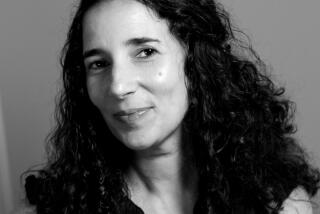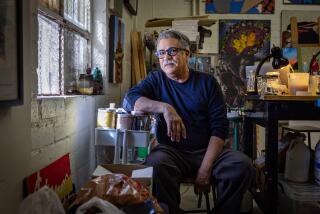In quiet yet visceral works, Zoe Leonard captures the frailty, pain and eccentricities of human life
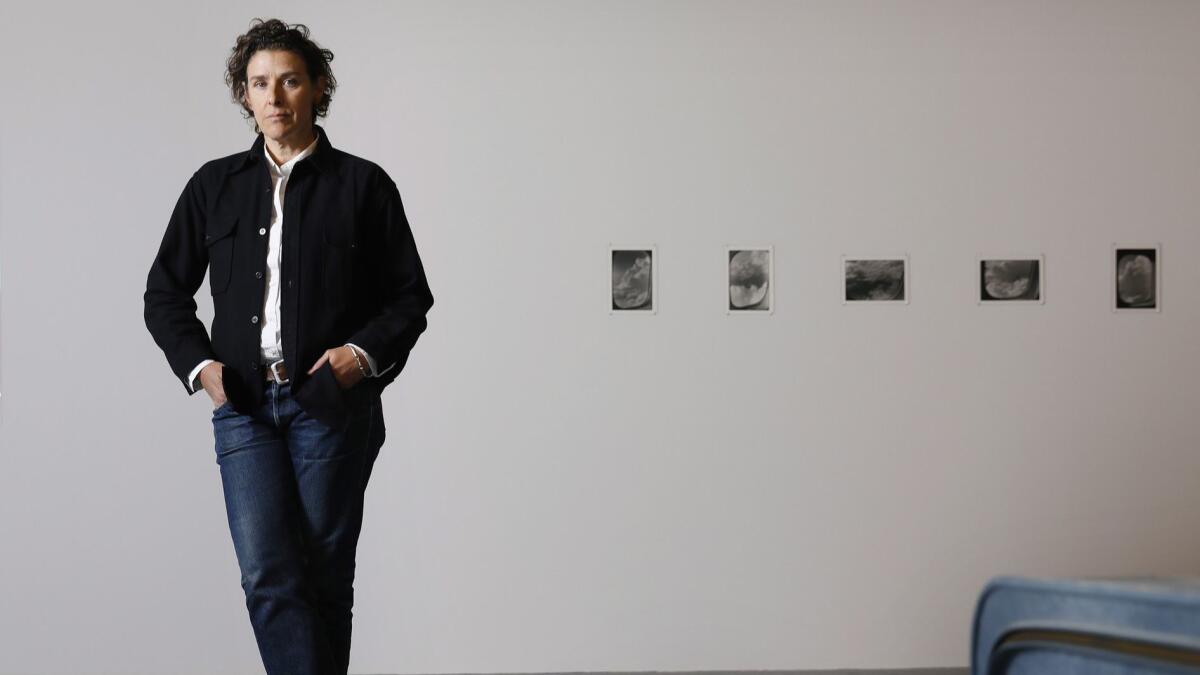
As symbols go, Niagara Falls offers plenty: a source of power, daredevilry, a bucolic vacation. For members of the various Iroquois nations who inhabited the area, this was the landscape from which thunder originated. For European settlers (including inventor Nikola Tesla), it became a source of electricity. It has drawn stuntmen and women intent on conquering its cataracts in barrels, kayaks and at least one jet ski, as well as countless couples in giddy states of honeymoon. Advances in printing techniques and the development of photography in the 19th century cemented its profile as a postcard trope.
The ubiquity of the falls’ image in photography, in film (cue Marilyn Monroe in the 1953 noir flick “Niagara”) and in the national imagination is something that artist Zoe Leonard adroitly picks apart in her installation of 6,266 Niagara Falls postcards arranged in vertical stacks on a studio table. It’s one of the pieces on view in “Zoe Leonard: Survey,” her midcareer retrospective at the Museum of Contemporary Art’s Geffen Contemporary branch in Little Tokyo.
Leonard, a photographer who makes sculpture, a sculptor who writes, a writer who employs photographs in ways that go beyond image, defies easy categorization. She can channel an activist’s righteous rage — a 1990s installation featuring the husks of withered fruits remains a visceral memento mori of the ravages of the AIDS epidemic. And just this year Instagram temporarily censored a re-posting of her 1992 text “I Want a President” allegedly because it used terms considered pejoratives for gays and lesbians to say she wanted an outsider to lead the country. But much of Leonard’s work might best be described as quiet, cerebral, methodical, observant.
In her Niagara Falls piece “Survey” (2009-12), for example, the meticulous stacks of postcards — some just a few cards, others that teeter with dozens of the most popular views — quite explicitly dwell on the physical nature of imagery. Each postcard represents a vantage point from which the falls have been photographed. Seen from below, they embody breathtaking might; from above, it is possible to absorb their majestic scale. From other angles, they seem composed of contradictory elements: turbulent waters, angelic mist. Together, they create a fragmented portrait and reveal the ways in which a camera, pointed in any one direction, can leave entire worlds out of view.
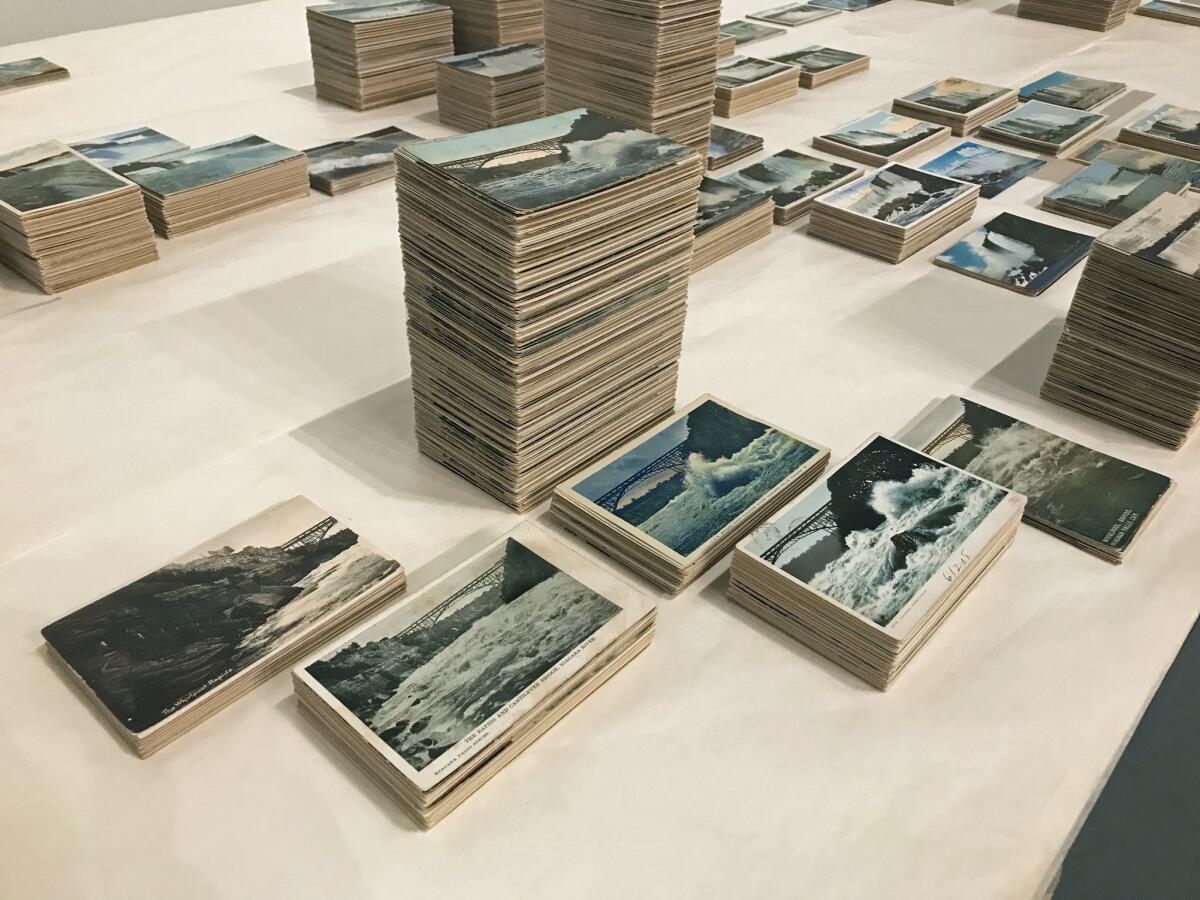
“From 19th century ideas about God and the sublime,” says Leonard, seated inside MOCA’s reading room, “to ideas of nationhood, power, electricity, then sexuality, the honeymoon, Marilyn Monroe, and a kind of nostalgic view of American greatness, how many social, political and economic ideas have been projected on this place?”
The installation also reveals the artist’s obsessive archiving tendencies.
“I guess it’s fair to say,” Leonard says, cracking a smile, “I collect postcards.”
“She’s always interested in photography as an image and an object,” says Rebecca Matalon, co-curator of the MOCA exhibition. “She asks us to question how and what we see, how our ways of looking are constructed.”
That questioning has been the connective tissue throughout a three decade-long career in which Leonard, 57, has produced or compiled images about the systems that humans create, and the ways in which those systems can at times overtake them.
In some of her earliest images, taken in the mid-1980s, she recorded landscapes through airplane windows: cities, rivers, roads, railroads, a single boat leaving a faint wake in an expanse of ocean. She also took pictures of maps, their folds evident, their edges clearly rendered within the frame — as if noting the limits of human omniscience.
“It’s the idea of mapping,” says Matalon, “which is both a mapping of a topography and a typology, a mapping not only of a landscape, but the way a landscape is bought and sold and presented as an image.”
A traveler’s eye
Leonard did not go to art school. But her upbringing provided her with an impromptu arts education. Her family “didn’t have any money,” but because her mother worked for an airline when she was a kid, they traveled regularly. “My mom was very interested in ancient Greece,” she recalls. “We’d go look at ruins.”
When Leonard was in her early teens, her mother went back to school to study architecture. “So I really grew up looking at space, thinking about space, thinking about space and architecture as a forum for human interaction,” she says.
From the time she was a teenager, she was drawn to writing and picture-making. “It was the notebook and the camera,” she says. “Something about it really stuck. I think it’s that relationship to the outside world and these acts of observation.”
Some of her early images depict museums — both artistic and scientific — tracking the ways in which objects are displayed, the ways in which the female body is presented for purposes of both study and enticement, and the ways in which faded mirrors reflect back a reality that is grainy and incomplete.
Her work is “subdued,” notes Matalon. “But there is this affect, this near melancholy because of the way it feels and because it’s often absent of people. There is this possibility that we just missed something or something is about to happen.”
“There is this affect, this near melancholy because of the way it feels and because it’s often absent of people.”
— Rebecca Matalon, curator
Her art began to draw attention in the 1990s, when she produced a series of works that touched on issues of memory, gender, inequity and invisible systems of control.
In 1992, she created one of the more electrifying site-specific installations at Documenta 9, the every-five-years exhibition in Kassel, Germany, when she placed close-up images of female genitalia — photographs of lovers and friends — between old master paintings of female figures in the city’s Neue Galerie. The exhibition pinballed between views of women by men with views of women by a queer woman.
“With its cool but startling blend of aesthetics and politics, art history and autobiography,” New York Times critic Holland Cotter has written of the project, “the piece was an instant landmark in queer feminist art.”
That same year, she worked on two significant pieces that have served as poetic rejoinders to the AIDS epidemic.
The first was “Strange Fruit,” the installation of dozens of desiccated peels of fruits she had consumed, all painstakingly reassembled over five years with zippers, wire and thread. The work (which like the Neue Galerie installation, is not part of the MOCA exhibition) functioned as a contemporary take on the still life and a poignant tribute to a close friend who had succumbed to AIDS. She told an interviewer in 2002, it was about “the conflict between hanging on and letting go.”
The second was her typewritten “I Want a President” text — frequently described as a poem — that was partly inspired by poet Eileen Myles’ write-in candidacy for the U.S. presidency in 1992. The original, single-spaced text, typed on frail onion-skin paper, with cross-outs and uneven deposits of typewriter ink, hangs in the galleries at the MOCA exhibition — conveying a sense of urgency with its words as much as its form.
Among its declarations: “I want a person with aids for president. ... I want someone with no health insurance and I want someone who grew up in a place where the earth is so saturated with toxic waste that they didn’t have a choice about getting leukemia….I want someone who has … had a cross burned on their lawn and survived rape.”
“What bubbled out in that text was informed by a whole context of what the AIDS crisis looked like before there were any medications,” she recalls. “It was this intense moment of explicit homophobia, the culture wars around the [National Endowment for the Arts] and defunding. There was this huge rise in the presence of the Christian right ... a whole matrix of things that were happening.”
Leonard wrote the piece for a small magazine that folded before it could publish the work. But in 2006 a friend saw it tacked up on her fridge and enlisted her to produce it as a postcard insert for a journal produced by the queer feminist collective LTTR. Since then, it has been circulated and recirculated and employed in public readings.
In the weeks before the 2016 presidential election, the piece found new relevance after it was blown up to a 20-by-30 feet image and displayed on New York’s High Line. And with the Instagram ban earlier this year, when the authors of a book on queer history posted it, the text again made headlines. (Instagram, which removed the piece the piece on the grounds that it violated community guidelines, reversed its initial decision.) “In a weird way it backfired,” says Leonard, who is not on Instagram. “When some people heard that it was being taken down, a bunch more people posted it and it became this viral thing.”
“As an artist, I’m flattered that a work of mine is still considered really significant,” she adds. “But I wish it wasn’t still relevant.”
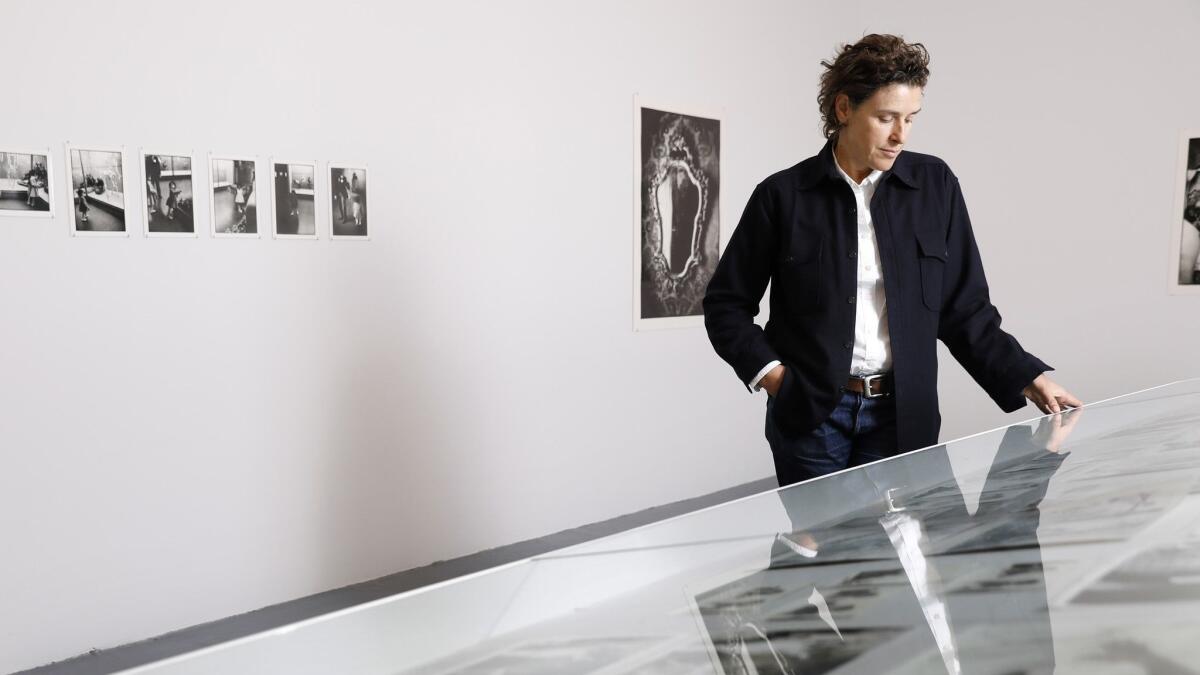
The ’90s also saw Leonard begin work on another significant series, currently on view a couple of blocks away from MOCA’s Geffen Contemporary, at Hauser & Wirth. Produced between 1998 and 2009, “Analogue” is a record of the mundane — mom-and-pop storefronts in New York and other cities — as well as the larger, unseen forces that control the movement of goods throughout the global economy.
In the windows of Lower East Side storefronts, she captured bundles of textiles, shoe displays and architectural arrangements of tin pans. In Mexico, she documented the bright plastic piles of cheap, Chinese-made goods. In Uganda, she photographed the literal signs of the rag trade — as in: the painted, storefront signs that advertise used clothing from the U.S.
The photos, shot with a pair of square-format Rolleiflex cameras, do not contain people, but they reveal the ways in which humans arrange and compose: towers of buckets, the faded layers of barbershop posters, geometric arrangements of men’s shirts. “The human figure is never far out of frame,” says Leonard. “You are aware of people, their handiwork, their decisions, their bodies.”
But each image is also emblematic of the destructive nature of the global economy, in which cheap, imported goods sideline local craft. “The presence of used clothes in Africa and Asia and Latin America undercuts the ability of these countries to develop their own textile industries,” she says.
The images function like a fragmented map of humanity: the artful bits of human accretion, the abjectly beautiful, the ways in which invisible forces come together and fall apart.
In the gallery at MOCA, she arranges decades worth of photo manuals to reveal the ways in which photography can channel the aspirational (a family, a house and a dog), and a row of old suitcases — an evolving work in which each banged-up vessel represented a year in her life.
In a rear gallery stands “Tree,” her 1997 sculpture, which is an actual tree that had been struck by lightning and then dissected by Leonard into several pieces and reassembled with the aid of steel plates. It’s a once-living being whose symbolic, life-giving attributes retain its form, but not its original spirit.
Like “Strange Fruit,” the sculpture “bears the impossibility of reconstituting anything,” says Matalon. “The idea that it’s impossible to put the pieces back together as much as we try.”
“Maybe it’s a Frankenstein story,” says Leonard, “how in the reconstruction of something there are gaps and missing parts and it’s a kind of fissure.”
She pauses.
“It’s beautiful,” she adds. “But also monstrous because it looks so unnatural.”
A fitting monument to the things humans do.
“Zoe Leonard: Survey”
Where: The Geffen Contemporary at the Museum of Contemporary Art, 152 N. Central Ave., downtown Los Angeles
When: Through March 25
Info: moca.org
“Zoe Leonard: Analogue”
Where: Hauser & Wirth, 901 E. 3rd St., downtown Los Angeles
Through: Jan. 20
Info: hauserwirth.com
ALSO
Critic’s Notebook: LAUSD caves to claims of racism on a school mural. It’s deplorable
Best art of 2018: Jasper Johns, Renaissance nudes, ‘Made in L.A.’ and a sleeper hit at LACMA
How artist Sandy Rodriguez tells today’s fraught immigration story with pre-Columbian painting tools
Sign up for our weekly Essential Arts & Culture newsletter »
carolina.miranda@latimes.com | Twitter: @cmonstah
More to Read
The biggest entertainment stories
Get our big stories about Hollywood, film, television, music, arts, culture and more right in your inbox as soon as they publish.
You may occasionally receive promotional content from the Los Angeles Times.

